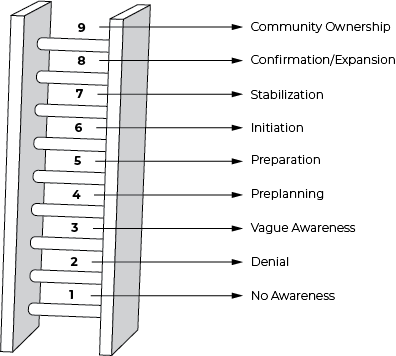Local communities and their leaders are often at very different stages of awareness and readiness for addressing identified needs and supporting planned interventions. People will have concerns and preoccupations, but if these are addressed they will be more likely to engage in the change. Supporting communities to move to more advanced levels of readiness can greatly enhance the probability of implementation success. This section of the guide briefly describes the nine stages of community readiness and lists strategies than can be initiated to advance the level of readiness (Edwards et al., 2000).
Multiple communities will be involved in an intervention. The assumption underlying this model of community readiness is that teams have already engaged with the community of interest to identify issues that address their needs (i.e., in Stage 1 – Exploration and Design). At this stage, we need to identify the different communities and stakeholders within organizations and members of vulnerable populations that will be directly involved in the intervention.

The nine stages of Community Readiness with suggested strategies for advancement to the next level are as follows:
- No Awareness – The community and its leaders don’t recognize the issue as a problem. “It’s just the way things are.”
- One-on-one visits with community leaders and members
- Visit existing and established small groups to inform them about the issue
- Make one-on-one phone calls to friends and potential supporters
- Contact with people in places where things are different
- Denial – Little recognition that there is a local problem except for a few people. No one thinks anything can be done about it.
- Continue one-on-one visits and encourage assistance
- Discuss specific local incidents related to issue
- Generate media articles about above incidents
- Submit articles to local newsletters, clubs, religious groups
- Present information to community groups
- Vague Awareness – There is general feeling among some that there is a local problem and that something ought to be done but no motivation to act.
- Present information at local community events
- Post flyers, billboards, social media
- Initiate your own events (potlucks, etc.)
- Conduct local surveys, interviews
- Publish newspaper or blog editorials
- Preplanning – At least some in the community think there is a problem and something should be done about it.
- Visit and develop support of community leaders
- Review above existing efforts
- Conduct local focus groups
- Increase media exposure
- Preparation – There is planning going on with some focus on practical details.
- Conduct community surveys
- Present in-depth local statistics
- Conduct public forums (can use deliberative processes – see Appendix D)
- Ask key local leaders to speak to groups and participate in media events
- Initiation – At least one activity or action is underway to address the local problem.
- Conduct in-service training for professionals and para-professionals
- Plan publicity efforts associated with start-up
- Attend meetings to provide updates on progress
- Conduct consumer interviews to identify service gaps
- Stabilization – One or two programs are running and receiving some community support.
- Conduct training for community members and professionals
- Hold special recognition events for local supporters and volunteers
- Begin networking between service providers and community systems
- Submit media articles detailing progress and future plans
- Confirmation/Expansion – Standard efforts are in place and community leaders are seeking expansion and improvement.
- Formalize networking with official service agreements
- Publish localized program services directory
- Develop local speakers bureau
- Maintain comprehensive database
- Community Ownership – Highly trained staff and sophisticated data with effective on-going evaluation characterize well-established efforts to address the local problem.
